
Last year my wife and I bought a 1961 ranch-style house, and I’ve been having a lot of fun fixing it up. I wrote about the problem with the spray foam in the attic not covering the top plates and how I fixed it when we had the soffits, fascias, and gutters replaced. I’ve also had a lot more spray foam installed in the attic because the original attic encapsulation was pretty bad. And I replaced the old natural draft gas water heater with a beautiful new Rheem heat pump water heater. (I’ll write about both of those topics sometime this summer.)
The other big thing we’ve done so far is to install a Mitsubishi* heat pump system to serve the first floor. It’s got one outdoor unit and two air handlers in the conditioned attic. Canton Heating & Air* installed the system and did an exceptional job. They specialize in Mitsubishi equipment, especially ductless, and their dedication to high quality workmanship shows. If you’re looking for minisplits in the Atlanta area, you can’t go wrong with them. (Yes, they gave us a discount, but I’d say the same things even if they hadn’t.)
You’re probably wondering how I zoned the house, what our heating and cooling loads were, and why I undersized the system, so let’s jump into the details.
*Disclosures: Mitsubishi gave us a discount on the equipment and advertises in the Energy Vanguard Blog. Canton Heating & Air gave us a discount on the installation.
Zones and loads
I did the load calculation and most of the design work for the system we installed. (Canton Heating & Air helped flesh out the details of the pair-of-pants fittings, which I’ll discuss in the next article.) The floor plan is shown below, and the first thing I did was divide the house into zones. The bedrooms on the left compose one zone (green). The common areas on the right are another zone (pink). And the sunroom needs to be its own zone (blue) because of all the glazing. About 60% of the three exterior walls in that room is covered with windows (double-pane, from the 1980s or ‘90s).
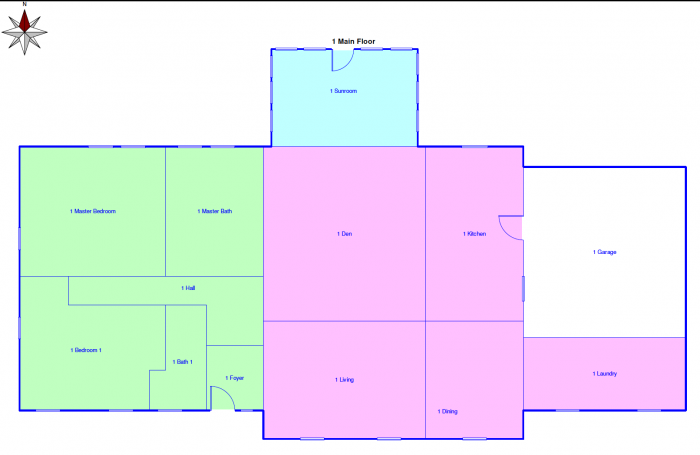
We use RightSuite Universal for HVAC design at Energy Vanguard, and that’s where the results you see in this article came from. Here are the specifications I used in the Manual J load calculation:
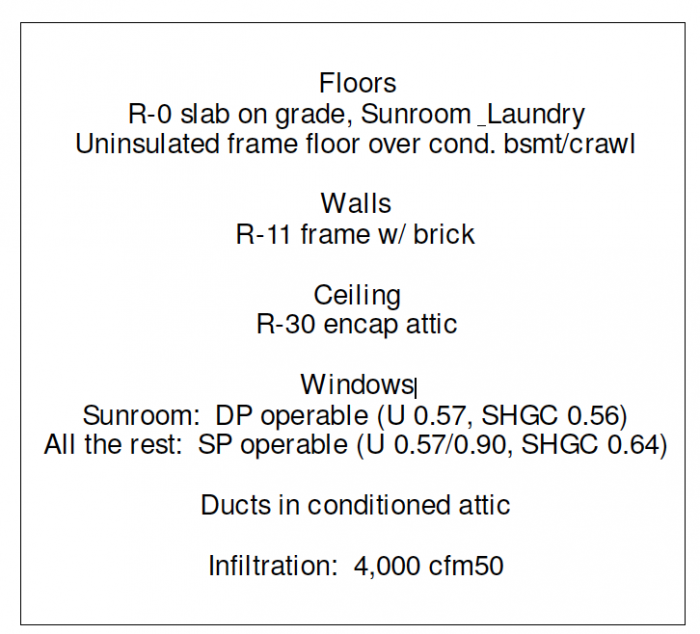
Let me explain a little about the inputs. Except for the sunroom and laundry room, everything else sits over a conditioned basement or conditioned crawl space. Except they’re not directly conditioned at the moment. After we put the new system in the encapsulated attic, we had the old furnace and air conditioner removed. The 110,000 Btu/hr and the 4 ton air conditioner served the entire house as one zone. It wasn’t great, but the upstairs was mostly okay. The basement was always too cold, though, as you would expect with this setup. Now the basement is indirectly conditioned, which adds to the heating load of the main floor but probably helps the cooling load.
I modeled the ceiling as R-30, but it’s really more like R-40 now. Woodman Insulation gave me more than I asked for when they added to the existing spray foam insulation up there. And I cheated a bit on the infiltration rate. My last blower door test, which I did after the new spray foam and my extra sealing work at the top plates, came in at 5,200 cfm50 (~9 ACH50) for the whole house. So, the attic insulation is actually better than modeled and the air leakage is worse than modeled. don’t recall why I did it that way, but those two deviations probably come close to canceling each other out.
In the window inputs, DP stands for double pane and SP stands for single pane. U is the U-factor, the reciprocal of the R-value. SHGC is the solar heat gain coefficient. Most of the single pane windows have storm windows, which explains the 0.57 for some of the SP windows.
I used the standard indoor design temperatures (70°F for winter, 75°F for summer) and Atlanta outdoor design temperatures are 23°F for winter and 93°F for summer. With all those entries, the loads and floor areas for the three zones are:

Note that the heating loads in all three zones are higher than the cooling loads. This surprises a lot of people, but it’s common around here. The sensible heat ratios (sensible cooling load divided by total cooling load) are all above 0.8, with the sunroom coming in at 0.92. All that glazing adds more to the sensible load than to the latent. And, in case you were wondering, the cooling loads expressed as square feet per ton are 1,537 sf/ton for the bedrooms, 1,123 sf/ton for the common areas, and an eye-catching, rule-of-thumb-like 394 sf/ton for the sunroom (windows again).
Sizing the equipment
So, what size heating and air conditioning equipment did I choose? First, let me tell you my thinking. I don’t want equipment that will satisfy the loads in the house as it is. I’ll be gutting and remodeling the basement fairly soon. (I’ve got a book to finish first, though.) After that, I’ll start working on the main floor, with more air-sealing and new windows and major renovations of some areas (the master bath, for sure). Because of those plans, I want equipment that will be a bit undersized. Besides, I know that even when I do a Manual J load calculation correctly, it still comes up with a load that’s about 10% to 20% higher than the actual load.
The equipment I selected includes one outdoor unit, the Mitsubishi MXZ-3C24NAHZ2 with HyperHeat, and two horizontal ducted indoor units. Because there’s only one outdoor unit, this is just one heat pump. The total capacity of the system is based on what that outdoor unit can do because that’s where it dumps the heat it removes from the house in cooling mode and where it pulls the heat from to send into the house in heating mode. Our nominal total capacity is 2 tons; the “24” in the outdoor unit model number stands for 24,000 Btu/hr.
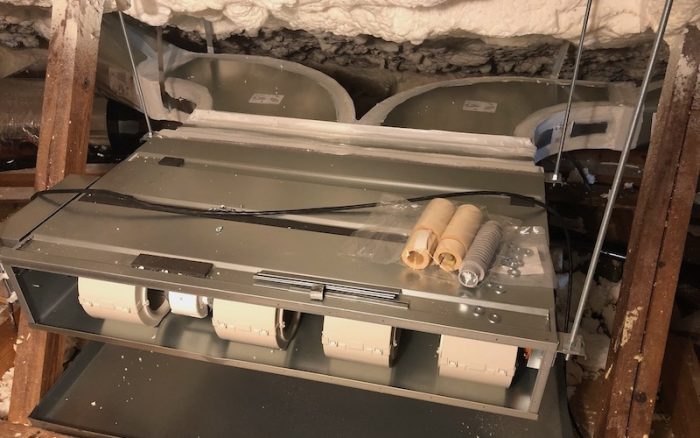
The ducted minisplit air handlers serve all of the main floor except for the sunroom, to which I’ll be adding a separate wall-mounted unit soon. The bedrooms zone is served by the Mitsubishi SEZ-KD09NA4 (shown above), and the common areas have the Mitsubishi SEZ-KD18NA4. Focusing just on these two main floor zones, here are the loads and the capacities of the equipment:

Since the total capacity of the system is dictated by the outdoor unit, here’s what the totals look like:

The capacities shown in both tables above are from Mitsubishi’s software called Diamond System Builder. As you can see, the numbers don’t look too bad for cooling, with a total capacity deficit of about 2,500 Btu/hr. But the heating capacity is 11,000 Btu/hr lower than the load. Can that possibly work?
Did the house stay warm enough?
I intentionally undersized the equipment installed in my house because I don’t want future improvements in the building enclosure to leave us with too much capacity. The total cooling capacity is only 88% of our cooling load, and the heating capacity is a mere 65% of the design heating load. Astute readers will have noticed another problem with the cooling capacity, but let’s deal first with the mode I have the most experience with: heating.
We got the heat pump installed with both air handlers operating in November 2019, so we’ve been through one whole winter with it. Oh, did I mention we didn’t install any supplemental heat? It’s true, but we have lots of sweaters and blankets, so we survived. Just kidding. We didn’t need any supplemental heat this past winter.
Yeah, the winter wasn’t terribly cold, but we did get tested a bit. We had about 2,200 heating degree days(HDD) December through April, which is below the Atlanta average of about 3,000 HDD. We did have a three-day stretch of cold weather when it got down close to our outdoor design temperature each night. The night-time lows were 25°F, 24°F, and 25°F, with daytime highs of 37°F, 40°F, and 49°F. The house stayed warm the whole time. We woke up to an indoor temperature a bit below the thermostat setting, but it caught up when the day warmed up. If we’d had colder weather with daytime highs in the low 20s, I think we would have needed supplemental heat.
So, I’m not worried about the heat right now. Manual J heating loads don’t count interior loads, so our bodies and the appliances that give off heat all help. Once I get done improving the building enclosure, the loads should drop and be a lot closer to our heating capacity.Even before the improvements, we have some flexibility because of the two air handlers. If it stays really cold for a few days, we can do most of our heating in the common areas zone during the day and keep the bedrooms cooler than normal. We usually sleep with the bedrooms cooler anyway.
The cooling effectiveness, so far
The total cooling capacity is 88% of the cooling load, so we’ll be tested on hot days. So far, we’ve had temperatures right at 90°F, just a few degrees below our summer design temperature of 93°F. The air conditioner hasn’t had any trouble cooling the house to the thermostat setpoint yet.
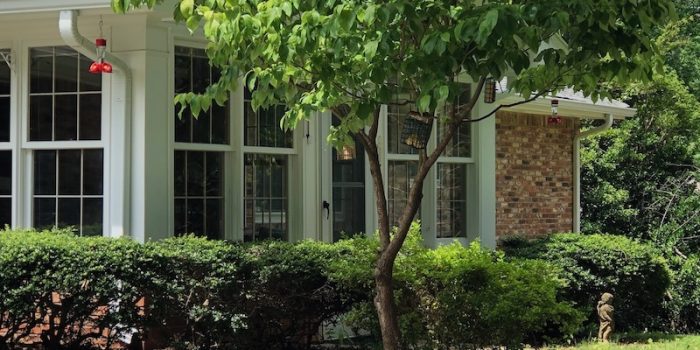
But I’ve done another little experiment to push the system further. Since the cold weather ended, we’ve been opening up the sunroom (shown above), which is connected to the den by a set of French doors. On the hot days we’ve had so far, the den and sunroom both cool to our usual setpoint of 74°F. To cool the den with sunroom doors open, though, the system has to run more than it was designed to run. That leads to the living room going down to about 71°F because the thermostat is in the den. With the sunroom doors closed, the temperatures even out pretty well. We’re about to get a wall-mounted ductless minisplit for the sunroom, and that’ll make this problem disappear.
Now, I alluded to another cooling problem, and it’s related to humidity. According to Mitsubishi’s software, our total latent capacity is only 718 Btu/hr whereas our latent load is 3,803 Btu/hr. If that’s correct, our system will do little dehumidification. I haven’t measured the amount of condensate coming out of the system yet, but I’m pretty sure we have more than 718 Btu/hr of latent capacity. We’ve had some warm, humid days lately and the humidity in the house hasn’t gotten out of control. Our dew points this week have gotten up as high as 72°F, and the indoor relative humidity is still mostly less than 60%. If I believe the separate thermo-hygrometer over the thermostats, it’s always less than the 60%.
In short, undersizing the system hasn’t resulted in uncomfortable conditions in our house (yet). And it hasn’t motivated me to accelerate my schedule of improvements to the house (yet). We’ll see how it goes as we get into hotter weather this summer and what happens when we have a real cold spell. For now, I’m happy with the reduced capacity.
Next time, I’ll cover the duct system, including filtration, for my two minisplit air handlers in the conditioned attic. Meanwhile, I’ve got to go see what the birds in my backyard are up to this morning. Those five bird feeders in the photo are only five of the eight I’ve set up.
–Allison Bailes of Atlanta, Georgia, is a speaker, writer, building science consultant, and founder of Energy Vanguard. He is also the author of the Energy Vanguard Blog. You can follow him on Twitter at @EnergyVanguard. All images courtesy of the author.
Weekly Newsletter
Get building science and energy efficiency advice, plus special offers, in your inbox.





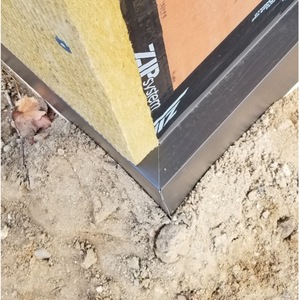

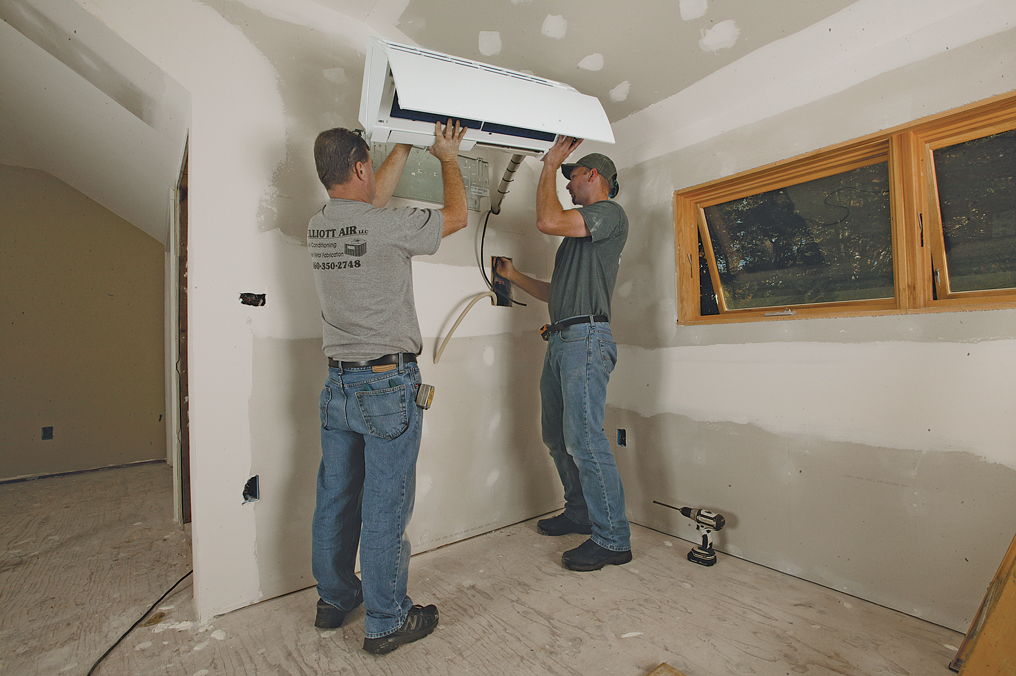







16 Comments
> We woke up to an indoor temperature a bit below the thermostat setting,
Would be interesting to log temperature and humidity in half a dozen rooms. Even more interesting if you also log outdoor temp and heat pump energy usage and post all of the data.
Jon, those are definitely things I plan on doing. I'll report more here when I have data.
I wish I had done this thorough job with calculations but I relied on the contractor too much. I have the exact same outdoor unit but it's connected to three wall units in the three bedrooms. I also have a separate wall unit in the main living area that has its own outdoor compressor- a msz-fh15na connected to a muz-fh15na- and the problem I have with cooling is with the lack of humidity removal in the bedrooms.. two of the bedrooms have closed cell spray foam in the wall and I have a lot of insulation in the attic. The system cools down and reaches the set temperature before enough humidity is removed. If I put them in dry mode it gets rid of the humidity but it's very cold in there after a few hours. The heating has been great though. The system is obviously oversized considering our house is only a little over 1,000 ft². Fwiw we live in the suburbs of Philadelphia and after 2 winters not using my old oil boiler/ hydronic baseboard I yanked it and the tank taking up space in my storage room, spray foamed the walls and ceiling and installed a rheem HPWH (April 2019) and so far I love it. I've just been driving myself a little nutty figuring out all the different ducting configurations. Last summer I pulled that nice hot air from the attic and exhausted into the storage room where the water heater is located. That made the unit run very efficient. Since the storage room isn't directly connected to the house, it has its own exterior door, I wasn't concerned about bathroom or oven fans or dryers creating vacuum and pulling heat from the attic into the house. This year I'm trying something different having the ntake and exhaust ducted behind my refrigerator knowing that it will make the water heater less efficient but it will help the air conditioning out in the house I assume. Sorry for getting off point there.
Cldlhd, my HPWH isn't ducted yet, but I do plan to do something like you've done. I've got a chase up to the conditioned attic where the old furnace flue is so I'm going to pull attic air for the intake. I haven't decided yet whether to send the HPWH exhaust air into the conditioned crawl space, the finished basement, or leave it in the mechanical room.
>"I wish I had done this thorough job with calculations but I relied on the contractor too much. I have the exact same outdoor unit but it's connected to three wall units in the three bedrooms. "
------------
>"... and the problem I have with cooling is with the lack of humidity removal in the bedrooms..."
That's a classic feature of the "ductless head in every room" gross oversizing problem. Most bedrooms don't have a load high enough to need even a half-ton head, and the minimum modulated output of that 3C24NAHZ cold climate compressor is pretty high, 13,100 BTU/hr @ +17F (pretty close to Philly's 99% outside design temp), so even in heating mode it may still be doing a lot more cycling rather than modulating when heating the bedrooms. A dedicated right-sized ducted mini-split like the SUZ-KA09NAHZ/SEZ-KD09NA or SUZ-KA12NAHZ/SEZ-KD12NA has a lot more modulation range to work with, and would run much much longer cycles, both summer & winter:
https://ashp.neep.org/#!/product/26170
...vs.
https://ashp.neep.org/#!/product/29053
...or...
https://ashp.neep.org/#!/product/31988
Oh I was under the impression that the 3C24NAHZ went down to 6000 BTUs. Guess it's worse than I thought. Might be a stupid question but if it only throttles down to 13,100 and I was only running one 9000 BTU wall unit how would that work?
It's a bit of a moot point as I already have the system installed but can those units you mentioned have ductwork run to multiple rooms or just one?
In the winter I often just run the one unit in the main living area and leave the bedroom doors open.
“[Deleted]”
Don't mean to hijack the thread but this is stuck in my head.... I was wondering if the mxz- 3c24na2 without hyper heat is the model with the higher minimum modulated output because I was looking at the Mitsubishi spec sheets and the one that lists NA for heating capacity at 5° F has a minimum cooling output of 12,600 BTUs but the one that lists heating capacity at 5°F as 25,000 BTUs lists a minimum cooling capacity of 6,000 BTUs. Fwiw the images with each spec sheet show totally different outside units with the hyperheat model with the broader range . To confuse me more the model #'s listed are MXZ-3C24NAHZ2 for the hyperheat and MXZ-3C24NAHZ2- U1 for the non hyperheat. My model is a hyperheat but has the former for a model number and the latter for a "service reference number". Any thoughts are greatly appreciated ..
The AHRI submittal sheet data is a bit confusing and at odds with how the thing actually operates normally, since the AHRI test calls for locking the frequency of the inverter for those tests in an attempt to create a more apples-to-apples comparison between models and vendors. (Whether that restriction for testing makes the comparison data better or worse isn't exactly clear to me.)
The NEEP test numbers does not have that restriction, but also ignores defrost capacity losses, and a few other oddities.
The most recent/current submittal sheet for the 3C24NAHZ2 indicates a minimum modulated output of 11,400 BTU/hr @ 47F which is consistent with the NEEP numbers (which were provided to NEEP by Mitsubishi)
https://nonul.mylinkdrive.com/files/MXZ-3C24NAHZ2_ProductDataSheet.pdf
https://ashp.neep.org/#!/product/26170
Any Mitsubishi multi-split with the appended -NAHZ (or NAHZ2, etc) at the end is a hyper heating model. The plain-NA (no HZ) are not hyper heating, and have less capacity at +5F, crapping out even faster at temps cooler than +5F.
A lot of the differences in recent submittal sheets of the same model numbers are most likely related to the operating firmware on the unit. If they discover that it runs more efficiently by cycling it on/off rather than modulating at low load, they will do that for the test. Sometimes there are subtle hardware changes that make a difference too. The equipment evolves faster that the model numbers. A relative of mine noticed when her FE18 got clobbered by a major power surge, and they repaired it by replacing several sub-assemblies that had gotten fried. It ran better and more efficiently after the repair than it had on it's first day of service.
That makes it sound like it's difficult for me to know the actual specs of my particular unit. It'd be nice if they had OTA updates. I'm no expert but I would think that lockng the frequency of the inverter would likely hurt efficiency.
So neither of the links/ specs you provided showed anywhere near the 6000 BTU minimum in the information I attached.
I'm trying a new workaround for the humidity issue in my bedroom. I'm assuming that when the wall unit cools the room down too quickly it's shutting down and leaving a lot of moisture on the coil and then when the fan is just blowing without the condenser running it's redistributing that humidity into the room. So I got a celio breeze plus and I'm trying the comfy humidity setting. If the humidity in the room gets above a certain level it puts the unit into dry mode and then when the humidity gets down to a low enough level it just shuts the unit off altogether so it doesn't put the moisture back out. I'm checking how long it cycles and I'm not sure how it will affect the efficiency. I was also wondering if leaving that moisture on the coil might give me some funky moldy type issues and require cleaning more often. It's only been a few days but so far it seems to work. I do like air moving when I'm sleeping so I run the haiku L my wife thought was a bit too expensive for a ceiling fan.....
In all your years doing this, have you ever seen a manual J be done and ultimately undersized equipment be put in that couldn't meet the load? It is interesting to see you under size by 30% and pretty much land just right on the heating side.
Matt, yes, I have seen a case or two where the system was undersized. Usually there's a problem with the Manual J when that happens.
In my case, having the Hyper-Heat unit helps, as it's supposed to be keep 100% of the 47° F all the way down to 5° F.
I don't see this mentioned very often, but the single zone mini-split heat pumps generally have a 3-point higher cataloged HSPF than the multi-zone units (13 vs 10). So if you are in a heating dominated climate, it appears to be better to select several single zone models than do the whole job with a single multi-head model. When I do a simple calculation of operating cost that difference makes a mini-split slightly less costly (for a single zone) or somewhat more costly (for the multi-head) than a condensing gas boiler in the northeast US.
I have a Mitsubishi multi split for the three bedrooms but a single zone for the general living area. The house is we insulated and only a little over 1,000 sq ft so in the winter I often just run the single zone and leave the bedroom doors open for that reason.
I have three SEZ units (three separate zones 15, 12 and 9) with a single MXZ-3C30NAHZ2 heat pump for 2100 sq ft in western MT (back up heat is a Napoleon 21K-30K BTU NG DV fireplace). In general I like the SEZ units. The internal condensate pump could be quieter (unit is quieter in winter), so I'd recommend gravity drain if possible (or Blue Diamond aftermarket pump?). On the SEZ-KD15, I just had the filter box replaced with the Mitsubishi FBL1-2 (1x34x12) (was formerly 2x5.625x33.5). Anemometer on tripod/centered at one of the supply ducts (unit has two 10" diameter metal ducts each to a 14"x14" adjustable double louvered grate) show the change made a significant difference (w/o filter 490 FPM, w/ MERV 8 filter 409 FPM and old box w/ MERV 8 filter 360 FPM - for Lo/Med/Hi new box 326/370/409 FPM and old box 279/318/360 FPM). When insulating the SEZ-KD15 unit with 2" Thermasheath Rmax (R-13.1), I noticed that the unit leaks air in two spots approximately above the coil (positive pressure side). The top sheet metal of the unit has an inset portion that meets the side walls and for some reason is not well sealed so I taped those junctions with 3M foil tape. As I continue to spot air seal the house/further insulate, I can see power usage drop. This winter, will be operating the SEZ-15KD more often on the high fan speed (529 CFM), now with better throw to help destratify great room (9' to 13.5' shed roof). Heat pump clothes dryer (Blomberg) works quite well too (worked for P&G Europe, mainly on Miele, maybe one day the US will adopt "ventless" dryers). While admitting all is not optimal, hope the above data may help people decide/size/zone as they try their best to follow Dr. Bailes incredibly useful/insightful advice.
Allison, When will you be doing part 2, I'm really interested in that part.
Log in or create an account to post a comment.
Sign up Log in